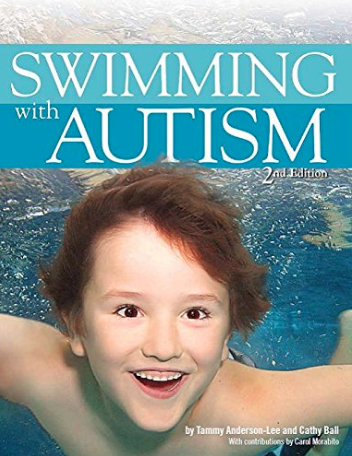
Swimming has a myriad of extraordinary benefits for the body and mind that can boost quality of life for individuals with autism. Swimming lessons for kids with Autism can help reduce the risk of accidental drowning—and bring more joy, confidence, and coordination into their lives. Lessons can also improve their learning in other areas, strengthen their bodies, and reduce anxiety. We’ve compiled some resources for you, including books on autism, peer-reviewed articles and blog posts. It’s important to educate and prepare yourself if you decide on using swimming as a form of therapeutic therapy.
It is a common understanding that children with autism are naturally drawn to water. Something about that shimmery, cool, flowing liquid seems to capture their interest. Even for ourselves, what’s better than sitting on the beach or by the pool on a warm summer’s day? Understanding how autistic individuals experience water helps us understand how to approach conversations about water safety.
Due to their water obsession, it is crucial to teach a kid with autism to always be safe around the water and what to do when they’re in the water to avoid drowning. Water safety training for people with autism is essential in preventing accidents. The best way to prevent drowning from occurring is to make sure that every child is provided with swimming lessons.
Books on Autism & Swimming
Swimming with Autism

For most children, learning to swim poses little difficulty, but for children with autism it can prove challenging. The usual methods to teach the different strokes may not quite click, and muscular issues could make moving through the water a challenge. Findings suggest people with autism may benefit from tailored teaching approaches and other supports. As far as books on autism and swimming go, this book is the best as it discusses different approaches and techniques.
Authored by Tammy Anderson-Lee & Cathy Ball, Swimming with Autism, is a great book with lots of helpful information. Anderson-Lee, the CEO of Aqua Pros Swim School, has been instructing and coaching swimming for 35 years. She has been teaching and creating aquatic programs for children with autism since 1995. Cathy Ball has dedicated 38 years to working with children and adults with special needs. This book has an easy to follow format, filled with images, scenarios and case studies. These examples explain in detail the successfully proven teaching methodology developed by Tammy Anderson-Lee.
Getting Into the Game

This book will help families, clinicians and coaches support children with autism in taking their first steps into sport and recreation.
Participation in individual and team sports plays an important part in children’s development and promotes growth in a number of areas. As well as the obvious health benefits, sport also teaches young people with autism about rules, strategy and teamwork. All invaluable lessons that can be applied to wider society. By detailing six of the most popular sports: cycling, ice skating, swimming, soccer, taekwondo and tennis, this book includes the unique experiences of families of children with autism. It offers all the information, advice and support needed to help get kids with autism engaged in fun and positive sport environments.
This book is an invaluable resource for parents, teachers, coaches and anyone supporting children with autism spectrum disorders in a sport or recreation environment.
Peer-Reviewed Journal Article on Autism and Swimming
A Pool-based Approach
The article talks about the benefits of pool therapy on autism. Lee and Porretta explain dynamic systems theory which, briefly, states motor skill acquisition varies on a student to student basis. Each student has varying experiences relative to the learning environment, the type of task(s) and how the tasks interact with the physical, physiological, and cognitive features of the individual.
A sample lesson plan is provided which can be used to guide instructors and parents alike. Instructors can use this lesson plan discretionarily. For example, the instructor can use it as a foundation for creating an individualized lesson plan. Or, the instructor can simply use the existing plan (if they assess it is appropriate for their student).
While not a book on autism, it is definitely a valuable read that will provide you with an overall understanding of what goes into planning swimming lessons for children with ASDs. Understanding how (specific) environmental factors, and certain aquatic tasks influence learning/experience in people with ASDs effectively equips you choose the right instructor. You’ll know what questions to ask the instructor and what to look for when they present their lesson plan and execute it. You may also gain a greater appreciation of what your child experiences when you consider dynamic systems theory. Having more knowledge on how to make their experience as comfortable as possible never hurts!
Elevate their Experience
Many children and adults on the autism spectrum have difficulty experiencing everyday sensory information. Take pool therapy to the next level and include sensory toys to make swimming more educational, comfortable and enjoyable. Sensory toys on their own work on these five aspects:
Social Skills: Kids learn to share, plan, and negotiate
Fine Motor Skills: Developing when they pick up small objects
Gross Motor Skills: When they have to jump or run or squat during an activity
Pretend Play: When your child uses objects during play
Self Control Skills: These are picked up when your child learns and respects the rules during play
Since both swimming and playing with toys are sensory activities, they work together to build language, social skills, increase attention span, develop motor skills, and help kids learn. Adding toys to pool therapy totally changes the way a child with ASD experiences the environment. Thus, opening up new and unique opportunities for play.
Find THE One
It’s very important to choose an instructor that has a plethora of experience, passion, empathy and patience. Make sure your child is going to have one-on-one instruction, this way they get the full attention and focus of the instructor. One-on-one lessons allow your instructor to adapt and tailor lesson plans unique to the student.
If a child is deaf and understands sign language, make sure their instructor can sign to them. This will make them feel comfortable about communicating. The same is true for children who stem, or yell in delight. Don’t try to stop your child from doing this. Let them have a hand flapping good time. Some children may act out with physical aggression. When this happens, it is pertinent that their instructor can handle such behavior in an appropriate and safe way.
Do you have any books on autism that have helped you learn more about ASDs and swimming? Let us know which books you swear by in the comments below!
Citation
Journal of Physical Education, Recreation and Dance
Volume 84, 2013 Issue – No.1
Pages 41-45 | Published online: 30 Jan 2013
Enhancing the Motor Skills of Children with Autism Spectrum Disorders: A Pool-based Approach
Jihyun Lee & David L. Porretta


